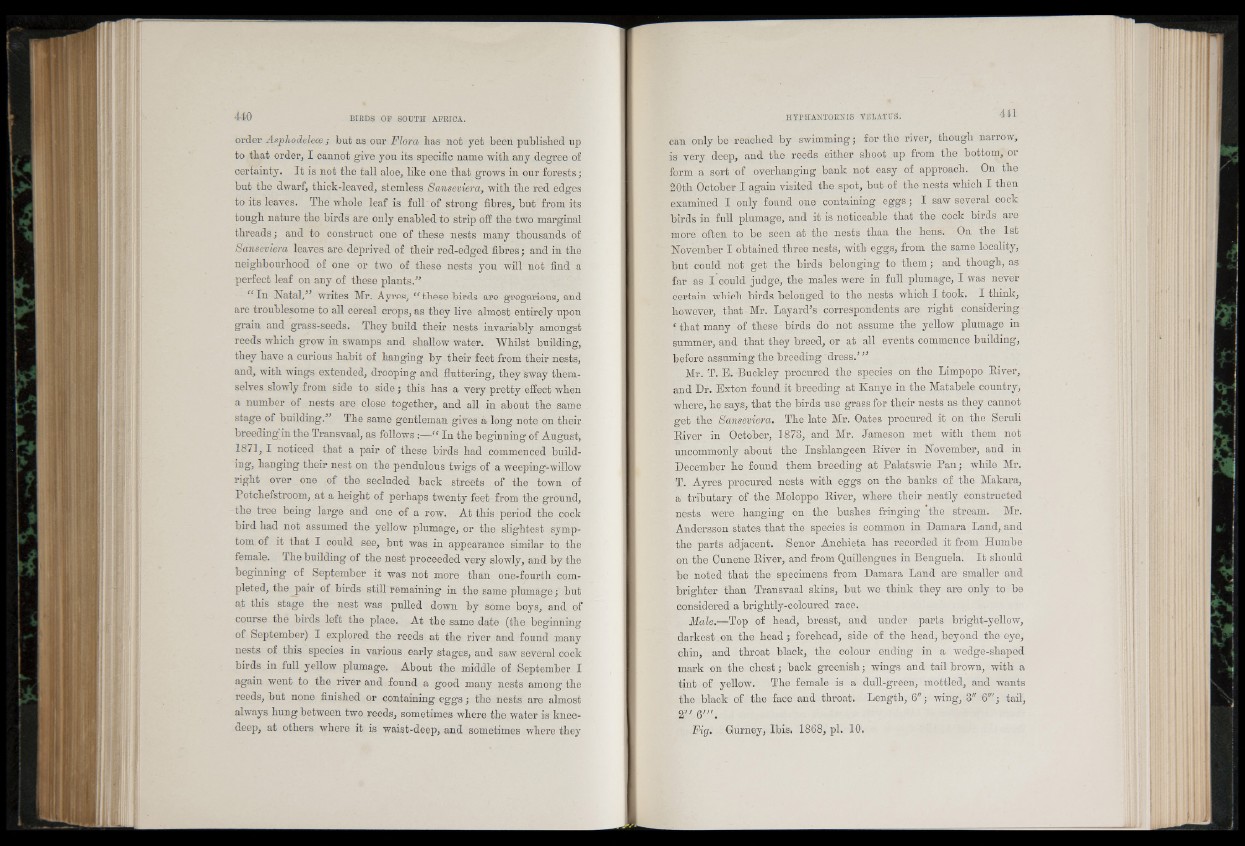
order Asphodeleoe; but as our Flora has not yet been published up
to that order, I cannot give you its specific name with any degree of
certainty. I t is not the tall aloe, like one that grows in our forests;
but the dwarf, thick-leaved, stemless Sanseviera, with the red edges
to its leaves. The whole leaf is full of strong fibres, but from its
tough nature the birds are only enabled to strip off the two marginal
threads; and to construct one of these nests many thousands of
Sanseviera leaves are deprived of their red-edged fibres; and in the
neighbourhood of one or two of these nests you will not find a
perfect leaf on any of these plants.”
“ In Natal,” writes Mr. Ayres, u these birds are gregarious, and
are troublesome to all cereal crops, as they live almost entirely upon
grain and grass-seeds. They build their nests invariably amongst
reeds which grow in swamps and shallow water. Whilst building,
they have a curious habit of hanging by their feet from their nests,
and, with wings extended, drooping and fluttering, they sway themselves
slowly from side to side; this has a very pretty effect when
a number of nests are close together, and all in about the same
stage of building.” The same gentleman gives a long note on their
breeding in the Transvaal, as follows ;—“ In the beginning of August,
18/1, I noticed that a pair of these birds had commenced build-
ing, hanging their nest on the pendulous twigs of a weeping-willow
right over one of the secluded back streets of the town of
Potchefstroom, at a height of perhaps twenty feet from the ground,
the tree being large and one of a row. At this period the cock
bird had not assumed the yellow plumage, or the slightest symptom
of it that I could see, but was in appearance similar to the
female. The building of the nest proceeded very slowly, and by the
beginning of September it was not more than one-fourth completed,
the pair of birds still remaining in the same plumage; but
at this stage the nest was pulled down by some boys, and of
course the birds left the place. At the same date (the beginning
of September) I explored the reeds at the river and found many
nests of this species in various early stages, and saw several cock
birds in full yellow plumage. About the middle of September I
again went to the river and found a good many nests among the
reeds, but none finished or containing eggs; the nests are almost
always hung between two reeds, sometimes where the water is knee-
deep, at others where it is waist-deep, and sometimes where they
can only be reached by swimming; for the river, though narrow,
is very deep, and the reeds either shoot up from the bottom, or
form a sort 'of overhanging bank not easy of approach. On the
20th October I again visited the spot, but of the nests which I then
examined I only found one containing eggs; I saw several cock
birds in full plumage, and it is noticeable that the cock birds are
more often to be seen at the nests than the hens. On the 1st
November I obtained three nests, with eggs, from the same locality,
but could not get the birds belonging to them; and though, as
far as I could judge, the males were in full plumage, I was never
certain which birds belonged to the nests which I took. I think,
however, that Mr. Layard’s correspondents are right considering
f that many of these birds do not assume the yellow plumage in
summer, and that they breed, or at all events commence building,
before assuming the breeding dress.’”
Mr. T. E. Buckley procured the species on the Limpopo River,
and Dr. Exton found it breeding at Kanye in the Matabele country,
where, he says, that the birds use grass for their nests as they cannot
get the Sanseviera. The late Mr. Oates procured it on the Seruli
River in October, 1878, and Mr. Jameson met with them not
uncommonly about the Inshlangeen River in November, and in
December he found them breeding at Palatswie Pan; while Mr.
T. Ayres procured nests with eggs on the banks of the Makara,
a tributary of the Moloppo River, where their neatly constructed
nests were hanging on the bushes fringing the stream. Mr.
Andersson states that the species is common in Damara Land, and
the parts adjacent. Senor Anchieta has recorded it from Humbe
on the Cunene River, and from Quillengues in Benguela. It should
be noted that the specimens from Damara Land are smaller and
brighter than Transvaal skins, but we think they are only to be
considered a brightly-coloured race.
Male.—Top of head, breast, and under parts bright-yellow,
darkest.on the head; forehead, side of the head, beyond the eye,
chin, and throat black, the colour ending in a wedge-shaped
mark on the chest; back greenish; wings and tail brown, with a
tint of yellow. The female is a dull-green, mottled, and wants
the black of the face and throat. Length, 6"; wing, 3" 6'"; tail,
2" 6” '.
Fig. Gurney, Ibis. 1868, ph 10.